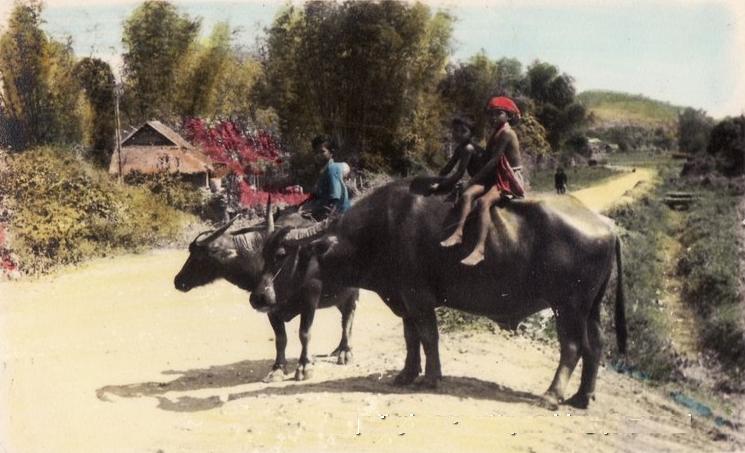
Malaysian Economy

Figure 1.--This tinted postcard shows us a scene in Penang during the 1930s. The Malay boys are riding the family buffalos. Malasia at the time was larghely agricultural and poor. Few Malay boys attended school. And no one preducted that within a few decades, Malaysia would become an Asian economic powerhouse. While socialists preach concepts like 'social justice' and 'capitalist exploitation', free market capitalism has proven in country after country the path to economic success and often. as in the case of Malaysia, rapid economic modernization.
|
|
The Malay Peninsula is a extended road block impeding ocean commerce between East and West. As a result, the Straits of Malacca are a major chokepoint in East-West trade. This was the case well before the Europeans era. Thus piracy from an early time was an important economic activity. The importance of the Malay Peninsula in trade drew Chinese merchants and the need to combat piracy drew the British to Malaya. The British established a major base at Singapore at the tip of the Peninsula and the eastern terminus of the Straits. Once there the British searched for resources to exploit. And they eventually found that the climate was perfect for rubber. British-contolled Malaya became the major world producer of rubber. The strategic importance of Singapore and the rubber are why the Japanese placed Malaya in the Southern Resource Zone (SRC) they sought to conquer during the Pacific War. There were also important mineral resources, including oil and tin. Malaysia at the time of independence (1957) still had an economy largely based on agriculture and the export of raw materials. This gradually began to change after the War and the British defeated the Communist insurgency. At the time Korea, Singapore, and Taiwan were emerging as the Asian Tigers. The growth in Malaysia was not as spectacular as in the other Asian Tigers, but it was still impressive. There are several factors involved in Malaysia's economic success, including free-market capitalism, British legal traditions, moderate Islam permitting democratic rule and communal peace, and valuable natural resources. The economic dynamism of Singapore was another important factor. The Asian Tigers unlike countries like Burma, China, Indonesia, and India were unburned by failed, costly experiments in socialist economics. A major problem faced by Malaysia was that the large Malay population was not only undeucated, but suspious of Western-style secular education--especially for girls. Malsaysia gradually developed a vibrant multi-sector economy. A series of government plans have aided economic growth. The country’s natural resources (agriculture, forestry and mining) helped provide needed funding and investment capital. Geography, especially the Strait of Malacca made ther country an important international shipping crossroad. The developmernt of an important manufacturing sector is particularly notable. Agriculture today involves only a small part of the population. Most Malaysians work in the industry and sevices sectors.
CIH

Navigate the Boys' Historical Clothing Web Site:
[About Us]
[Introduction]
[Biographies]
[Chronology]
[Climatology]
[Clothing]
[Disease and Health]
[Economics]
[Freedom]
[Geography]
[History]
[Human Nature]
[Ideology]
[Law]
[Nationalism]
[Presidents]
[Religion]
[Royalty]
[Science]
[Social Class]
[Bibliographies]
[Contributions]
[FAQs]
[Glossaries]
[Images]
[Links]
[Registration]
[Tools]
[Children in History Home]
Navigate the Boys' Historical Clothing national pages:
[Return to the Main Malaysian page]
[Return to the Main Asian page]
[Return to the Main country economics page]
[Afghanistan]
[Bangladesh]
[Bhutan]
[Cambodia]
[China]
[India]
[Indonesia]
[Pakistan]
[Singapore]
[Sri Lanka]
[Tajikistan]
[Turkmenistan]
[Uzbeckistan]
Created: 3:11 AM 11/14/2010
Last updated: 3:11 AM 11/14/2010



